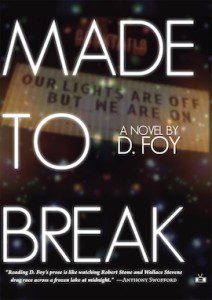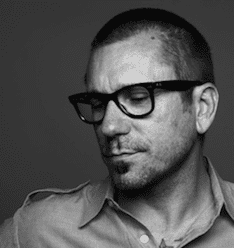
Probably the closest I’ve ever come to death was the New Year’s when my good friend Nate nearly took my head off with a shotgun blast. We were all drunk on a ranch in South Texas, and at midnight, through the twisted dance of bodies hugging other bodies, I saw Nate walk toward me with a 20-gauge, hoping to announce the New Year with a gunshot toward the open sky. I stood up to get out of his way right as he pulled the trigger; the gun went off inches above my right ear. I reeled and all sound went blank. Everyone else was pissed, and Nate stood holding the gun, in disbelief at what he’d almost done. Maybe what’s stupidest and most impressive about the whole thing, though, was how soon the night recalibrated, how quickly we returned to the drinks and the stories and the singing of songs. As if the near brush with chaos proved how resilient we really were, how death was just something you were bound to brush up against if you were friends with someone for that long.
One thing D. Foy’s menacing and dense first novel, Made to Break, understands extremely well is the strange, exhilarating, depressing, and often stupid and dangerous territory of longtime friendship. Foy strands five friends—AJ, Lucille, Hickory, Dinky, and Basil—at a remote cabin near Lake Tahoe over New Year’s. The novel spans only a weekend, but man is it a long one. Locked in isolation, the lines between friendship and parasitism blur completely, and love reveals its most painful fronts: cruel inside jokes, pissing contests, past hurts, and lots and lots of insobriety.
Heading into the weekend, things are already on edge; the group’s been on a cocaine-fueled bender since Christmas Day. The Tahoe trip serves ostensibly as an extended last hurrah for Lucille, who’s given up her dreams of becoming a painter to sell out to the world “of corporate jobs and big-big coin.” Lucille and Dinky dated at one point, but then Lucille slept with Basil so now she’s with him. AJ, who narrates, feels hounded by his own demons, caught up in his romantic feelings for Hickory while at the same time wallowing in profound self-doubt. “All I’d known in the days before was a lie,” he tells us in the novel’s opening moments, “I myself was a liar and a lie…”
The first thing they find at the cabin is a neglected lovebird, dead and rotting on the living room floor. We immediately see it as the coalmine canary, warning the group that a secluded, whiskey-flooded weekend together is the last thing they need. But the five friends can’t, or won’t, read the signs, and things get messy quick. Torrential rains hit Tahoe and mudslides cover the roads. AJ and Dinky wreck the truck, leaving Dinky with internal injuries and no egress to a hospital. The only thing left for them to do is wait out the storm and talk.
Foy’s initial setup calls to mind the frontier stories of Stephen Crane and Jack London, one where the scenic backdrop is less about a realistic rendering of space and more interested in creating a mythic, impressionistic arena for testing the ties binding a group of people together. The rain lashing Tahoe is intentionally hyperbolic, and Foy’s sound-driven descriptions read operatically. “The stars were dead. The night was rage. The earth was sick with danger,” AJ thinks on their first approach to the cabin. And later, “Trees flashed by, now sparkling, now black, a strobic land of bugaboos dreamed and real.” These are stage directions out of high melodrama, narrative description meant to ready us for the most heightened edges of human behavior: fear, the drive for dominance, and feral self-preservation.
This external landscape, of course, also mirrors the interpersonal weather brewing inside the cabin. As the days pass, the group’s drunkenness deepens while Dinky’s condition gets worse. With nothing to do but talk, secrets seep out and old wounds reopen. We learn of Hickory’s mysterious past, Basil’s sexual coming-of-age with a stuffed monkey, Dinky’s reasons for enlisting in the army, and Lucille’s numerous infidelities. Most importantly, though, we hear the long history of petty cruelties these friends have inflicted on one another over the years in the name of one-upmanship or the simple alleviation of boredom.

This drive for dirt and hurt feelings is perhaps the main thing keeping these characters together. AJ can sense a twisted logic in these rituals of self-laceration and humiliation, the way these hurtful conversations act as an interpersonal amphetamine that sustains the group and keeps it going:
The kill was just a dream. The sight of blood was enough. We were only after the blood. This of course was a perversion cultivated over time, like a taste for taboo food, monkey brain or mice. The satisfaction of knowing we’d wounded one another was more than sufficient. In fact, it had become for us a fix of sorts, why our hate for one another always equaled our need.
In between the sadistic bouts at the cabin, Foy introduces us to Super, a longtime local resident who might be the group’s only hope of getting off the mountain. Driving a pickup whose bed is littered with dismembered dolls, the broken-toothed Super operates as the novel’s spiritual guide. As he offers rides to the stranded or repairs the cabin’s downed phone line, he spouts cryptic wisdom, a gnostic in the midst of the great flood and perhaps the only character in the novel who sees the group’s precarious isolation as an illustration of a much darker cosmic truth:
It grieved him to his heart, Super said, that the powers had ever made human kind, and worse, that he’d been born unto humans. He praised the storm if only that it might blot from the earth not just him and Basil but all humankind, people together with animals and creeping things and creatures of the air. The earth was corrupt, he said, the earth was filled with violence.
This cosmic darkness, the earth’s default setting of violence, is at the core of Foy’s vision in Made to Break. And it affects AJ most profoundly. Once the rains finally temper around Tahoe, he’s the one who’s left to sort through the wreckage. He gives us his story in hindsight, now living alone in a trailer park outside Sacramento, where he scrapes together a living by transporting crops and cleaning school toilets at night. In these quieter moments, far removed from the heated events of the New Year’s weekend, AJ can survey the razed landscape of his friendships. He sees the scars he’s both inflicted and suffered, and his final appraisal reeks of resignation and self-loathing: “There are times you see the rot you’ve always been.”
At one point during the weekend, AJ goes looking for help and comes across an isolated tent in the middle of the storm. Its presence scares him initially—who knows what kind of fucked-up danger could be lurking in a tent on the side of a mountain—but he becomes even more frightened when he enters the tent and finds it empty:
And it was then I saw the nature of terror, because it was then the nature of my predicament, like a toxic cloud, swallowed me utterly up. Terror, I realized, had nothing to do with time and space but with the absence of them, and with the incomprehensibility of that absence. There before that rotting little tent empty in the night in the glade in the forest in the heart of a pulsing storm, the emptiness of my life, and of my aloneness in it, usurped my thoughts with cruelty I couldn’t fathom.
What frightens AJ most is isolation, the nothingness he knows is a fundamental fact. And on one level, his weekend—the drinking, his love for Hickory, his painful jousting with Lucille, Basil, and Dinky—shows how far he’s willing to go to stave off his own loneliness. In the end, for AJ, and perhaps for us all, it’s far less terrifying to reveal our softest, most vulnerable spots to cruel friends than it is to admit that, in the end, we’re all in this by ourselves.




